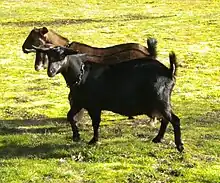 | |
| Conservation status | |
|---|---|
| Country of origin | United States |
| Standard | Kinder Goat Breeders Association |
| Use | milk, meat |
| Traits | |
| Weight | |
| Height | |
| |
The Kinder is an American breed of domestic goat. It originated on a farm in Snohomish, Washington, where in about 1985 an American Pygmy buck was cross-bred with Nubian does. The resulting stock was selectively bred to create a compact but well-muscled goat, suitable both for milk and for meat production. A herd-book was started in 1988; by 2006 about three thousand head had been registered.[2][4]: 392
History
The Kinder originated in about 1985 on a farm in Snohomish, Washington, in the north-western United States. There, an American Pygmy buck was cross-bred with Nubian does. The resulting stock was selectively bred to create a compact but well-muscled goat, suitable both for goat's milk and for goat's meat production. In 1988 a breed society, the Kinder Goat Breeders Association, was established, and a herd-book was started; by 2006 about three thousand head had been registered.[2][4]: 392 The breed has spread within the United States, where it is present in about thirteen states,[2] and also to Brazil and Canada.[4]: 392
The conservation status of the Kinder was listed by the FAO as endangered in 2007;[1]: 125 in 2020 DAD-IS listed its status as unknown.[2]
Characteristics
The Kinder is of moderate size, with a sturdy body inherited from the American Pygmy, but with the longer legs of the Nubian.[4]: 392 Height at the withers is 20–26 in (51–66 cm) for does and 20–28 in (51–71 cm) for bucks, with weights of about 115 lb (52 kg) and 135 lb (61 kg) respectively.[3] It is horned in both sexes, but in the United States is commonly disbudded. The coat is short; the breed standard does not specify any particular coat color.[4]: 392
Use
A Kinder doe may give some 680 kg (1500 lb) of milk in a lactation of about 305 days. The milk is claimed to have an average butterfat content of about 5.5%, occasionally reaching 7%;[4]: 392 it is high in milk solids, and is thus suitable for cheese-making.[5]
Like other goat breeds of tropical origin, the Kinder is an aseasonal breeder, and can be bred at any time of the year. It is a highly prolific breed – twin and triplet births are a normal occurrence.[4]: 392 The kids put on weight rapidly; the dressed weight after slaughter averages approximately 60%.[4]: 392
References
- 1 2 Barbara Rischkowsky, D. Pilling (eds.) (2007). List of breeds documented in the Global Databank for Animal Genetic Resources, annex to The State of the World's Animal Genetic Resources for Food and Agriculture. Rome: Food and Agriculture Organization of the United Nations. ISBN 9789251057629. Archived 23 June 2020.
- 1 2 3 4 5 Kinder / United States of America (Goat). Domestic Animal Diversity Information System of the Food and Agriculture Organization of the United Nations. Accessed November 2020.
- 1 2 3 4 5 Kinder Breed Standard. Kinder Goat Breeders Association. Archived 16 November 2020.
- 1 2 3 4 5 6 7 8 Valerie Porter, Lawrence Alderson, Stephen J.G. Hall, D. Phillip Sponenberg (2016). Mason's World Encyclopedia of Livestock Breeds and Breeding (sixth edition). Wallingford: CABI. ISBN 9781780647944.
- ↑ Kathleen Sanderson (2005). Kinder Goats, A small breed for milk and meat. Backwoods Home Magazine (95, September/October 2005).